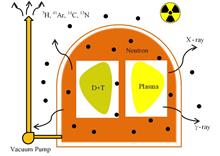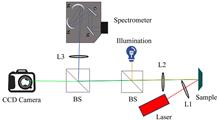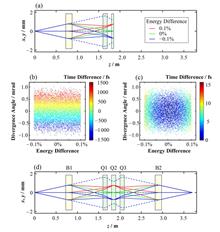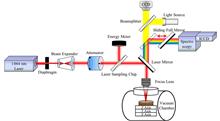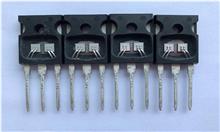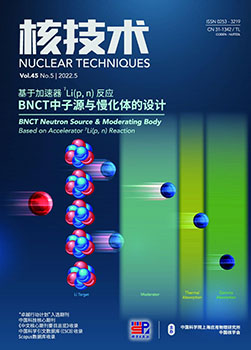
The nuclear fusion reaction using deuterium and tritium fuel produces a large number of neutrons, γ rays and activation products, which have an impact on the radiation safety of people and the environment. In order to reduce the impact of ionizing radiation, it is necessary to know accurately well the time and space distribution information of nuclear radiation field intensity in fusion device. The magnetic confinement fusion devices built in the world have established a complete nuclear radiation monitoring system according to their own operating conditions to deal with the potential impact of ionizing radiation. By monitoring the radiation dose during the operation and maintenance of the magnetic confinement fusion device, the ionizing radiation and radionuclide data of the experimental site and the surrounding environment are obtained, which provides data support for radiation safety protection management. Based on the investigation of radiation monitoring systems of magnetic confinement fusion device at home and abroad, the main ionizing radiation source terms and monitoring system architecture are reviewed in this paper, and the measuring methods and common detectors of neutron and γ radiation dose in magnetic confinement fusion are introduced. Finally, the research status of radiation monitoring system for nuclear fusion devices at home and abroad is summarized, and the development trend and goal of nuclear radiation monitoring system in the future are prospected.
BackgroundSynchrotron radiation experimental methods have unique advantages in studying the structure and physical properties of materials, but it is a challenge for many experimental methods to achieve synchrotron radiation in situ high temperature conditions, especially above 2 000 K. Laser heating methods can achieve rapid, micro-region extreme high temperature conditions, and have become an important tool for the study of high temperature physical properties.PurposeThis study aims to develop a portable laser heating device for Shanghai Synchrotron Radiation Facility (SSRF) in situ experiments in the field of extreme high temperature research, such as high entropy alloys, turbine blades, aviation materials, etc.MethodsA 100 W continuously tunable near-infrared fiber laser was used as the heating souce, the sample was heated up by laser through the focusing lens and generated thermal radiation. The radiation spectrum was collected through the spectral collection focusing lens and measured by spectrometers. The temperature gradient and temperature stability of the sample were fitted by the blackbody radiation method. Finally, the melting experiment of pure tungsten sheets in vacuum was conducted to verify its maximum heating temperature, and the temperature gradient and stability measurement of the device were calibrated with platinum samples.ResultsWe Experimental results show that melting point of about 3 695 K for tungsten sheets in vacuum is achieved using this device, and X-ray diffraction patterns of MoS2 and CTAB-MoS2 materials under 1 608 K in situ are obtained at the surface diffraction beamline station of SSRF.ConclusionsThe laser heating method developed expands the extreme experimental conditions in SSRF, and provides an important means to study high temperature physics for materials.
BackgroundThe electron beams produced by laser plasma acceleration have excellent quality for pulse lengths of the order of fs. Due to the existence of a strong laser field, there are difficulties in direct applications, and more applications need to transmit the electron beams to the application terminal. The energy spread leads to the generation of energy chirp of the electron beam in the transmission.PurposeThis study aims to explore the design of the beam optics to compress the pulse length and keep it on the fs scale.MethodsAn achromatic beamline consisting of bending magnets and quadrupole magnets was designed to compress the pulse length of electron beams. Critical parameters of an achromatic beamline were given by a derived formula. Transformation matrix was employed to investigate the differences of the pulse lengths in achromatic transmission and non-achromatic transmission. The pulse lengths of electron beams with different energies were scanned with different deflection angles (0.3 rad, 0.6 rad, 0.9 rad) and deflection radii (0.15 m, 0.25 m, 0.35 m) to study the influence of beamline parameters. Finally, the magnetic field gradients of the quadrupole lens were adjusted to realize the compression of electron beams with different energies in a beamline.ResultsComparing to non-achromatic transmission, the pulse lengths of electrons with the same energy and different initial divergence angles can be compressed effectively in the achromatic beamline. The larger the deflection angle or the deflection radius, the longer the pulse duration of the electron beam with higher energy (>25 MeV). By adjusting the magnetic field gradients of the quadrupole lens, the pulse lengths can be reduced from more than 100 fs to around 20 fs at higher energies.ConclusionsUsing a fixed-size achromatic beamline, combined with magnetic field strength adjustment, the pulse lengths of electron beams with different energies can be kept on the order of fs after transmission.
BackgroundLaser-induced breakdown spectroscopy (LIBS) is a new technology for testing and analyzing the composition and content of elements in materials.PurposeThis study aim to determine the content and distribution of hydrogen isotopes in hydrogen storage materials by using LIBS quantitative analysis technology.MethodsThrough independent design, construction and integration, a LIBS system was established for in-situ measurement of hydrogen isotopes in a vacuum chamber. Titanium sheets were used to prepare titanium-hydrogen samples with different concentrations of hydrogen and deuterium atoms to investigate the content and distribution of hydrogen isotopes in titanium using LIBS technology. The plasma parameters were calculated from the emission spectrum of titanium, and quantitative analysis on the content of hydrogen and deuterium atoms in the titanium sheet was carried out. Finally, the internal calibration method was employed to draw the calibration curves of hydrogen and deuterium, respectively, so as to determine the accuracy of this technology.ResultsThe plasma temperature calculated from the Boltzmann diagram is (16 000±1 000) K. Test results show that the linearity of calibration curves is increased by 4% by integrated intensity calibration, and the error of hydrogen isotope quantitative analysis is reduced by 2.8%. Based on the fitted curve, the concentration is consistent with the concentration determined by the pressure drop method during the sample preparation process. The average measurement error of hydrogen and deuterium is 3.19% and 1.94% respectively.ConclusionsProvided that the plasma state conforms to the local thermal equilibrium and the plasma temperature of different elements is consistent, LIBS quantitative analysis can accurately measure the contents of hydrogen isotopes by using the internal standard method. Signal enhancement effect and data accuracy of LIBS meet the requirements of quantitative analysis.
BackgroundSilicon carbide junction barrier Schottky (SiC JBS) diode is a kind of power device based on wide bandgap semiconductor. SiC JBS diode is expected to become an important part of electric propulsion systems in the radiation application field in the future space exploration due to its excellent high-voltage, high-frequency and high-power characteristics. However, there are a large number of protons in the typical orbit of spacecraft, which always threaten the stable operation of spacecraft, including its key components.PurposeThis study aims to explore the resist ability of SiC JBSs to the degradation of medium energy proton irradiation, and clarify the mechanism of radiation effect of SiC JBSs from medium energy proton.MethodsBased the proton equivalent displacement damage dose in low Earth orbit for ten years, the SiC JBSs were firstly irradiated using 10 MeV protons at fluences ranging from 3×109 cm-2 to 3×1010 cm-2 at room temperature and without bias voltage. And the macro electrical characteristics of the SiC JBSs both before and after irradiation, including the forward current-voltage (I-V), reverse I-V and capacitance-voltage (C-V) characteristics, were tested. Then the irradiation-induced defects characteristics were tested by deep level transient spectrum (DLTS). Further, the related degradation mechanism that was associated with this phenomenon was also investigated using based on the test data and mathematical calculation. Finally, irradiation experiments of accelerator protons were carried out for commercial SiC JBSs.ResultsThe results show that the forward electrical characteristic of the SiC JBSs is stable, and the leakage current decreases at low reverse safety voltage. But the rated breakdown voltage is seriously degraded with the increase of irradiation fluence. The main contribution to the change of SiC JBSs characteristics originates from the increase of interface charge, deep level defects and Schottky barrier height, and the decrease of carrier density and carrier diffusion length in the drift region.ConclusionsAnalysis of the radiation damage process and mechanism of SiC JBSs in this study provides a research basis for its evaluation and verification before applied to medium energy proton environment.
BackgroundThe comprehensive research facility for fusion technology magnet performance research platform (MPRP) is a large-scale experimental platform established for advanced superconducting magnet experiments. The retrieval speed of MPRP historical data is slow due to massive storage.PurposeThe study aims to develop a MPRP data archiving system (MPDAS) and increase its retrieval speed.MethodsFirst of all, the experimental physics and industrial control system (EPICS) data archiving plug-in was designed for MPDAS. Both MongoDB Sharding and Replica Set mechanism were employed to build a highly scalable data storage architecture. Then, the core ideas of three traditional cache replacement algorithms, LRU (least recently used), LFU (least frequently used) and FIFO (first in first out) were drawn by MPDAS to establish a data temperature model based on Newton's law of cooling. A multi-dimensional feature data partitioning algorithm was implemented to integrate access time, access frequency and storage order, hence the hot and cold historical data were identified to realize data tiered storage. Finally, the retrieval speed of MPDAS was improved by preferentially accessing Redis when querying historical data, and selecting different retrieval strategies based on hit results and data integrity.ResultsThe system test results show that the functional characteristics of MPDAS meet the design requirements. Compared with FIFO, LRU, and LFU, the Redis hit rate of the MPDAS when the hot database stores 1% of the historical data is increased by 38.05%, 26.91%, and 11.06% respectively.ConclusionsBy increasing the hit rate of hot data, the average response time of data retrieval can be directly reduced. The retrieval response speed of MPDAS is effectively improved by quantifying the heat of historical data and dividing the heat and cold.
BackgroundElliptical orbiting satellites passing through the inner radiation belt are exposed to high-energy and high-flux protons and electrons. Therefore, electronic devices of satellites need to resist ultra-high cumulative radiation doses.PurposeThis study aims to propose a composite material structure for shielding space protons and electrons, instead of the traditional aluminum structure.MethodsThe interaction of elliptical orbital protons and electrons with four shielding materials (polyethylene/polypropylene, tantalum and aluminum) was simulated by the MULASSIS (Multi-Layered Shielding Simulation Software). The radiation particle energy spectrum calculated by SPENVIS software was used as the input of MULASSIS particle energy spectrum. The changes of total dose and displacement dose after shielding with areal density of the four shielding materials were compared and analyzed. Finally, the most suitable composite shielding structure was selected by considering the proton and electron shielding effects and mechanical properties of the four materials.ResultsThe results show that under same areal density, the order of the shield effectiveness from large to small, of four different materials on orbital proton and electron is polypropylene, polyethylene, aluminum and tantalum, among which polypropylene and polyethylene have almost the same shielding effect. The polyethylene-aluminum composite shielding structure is selected for construction design. The shielding targets of total dose and displacement dose to ensure the reliable operation of elliptical satellites are 50 krad(Si) and 2×1010 p?cm-2 (equivalent to 10 MeV protons) respectively.ConclusionsCompared with the single aluminum shield, at least 27.8% shielding mass is saved by using the polyethylene-aluminum composite protective structure in the above ratio.
BackgroundCompared with the traditional pressurized water reactor (PWR), the core design of large advanced PWR CAP1400 has significant changes, such as the increase in the number of fuel assemblies, the increase in reactor power, the increase in the average temperature of core coolant, etc. These changes have an important impact on the results of rod ejection accident, and then affect the safety of reactor.PurposeThis study aims to verify the safety of large advanced PWR under rod ejection accident condition and the influence of key input parameters on accident analysis results.MethodsBased on the neutron dynamics software TWINKLE and fuel performance analysis program FACTRAN, the typical four types of operating conditions, including the beginning of life the hot full power and the hot zero power, the end of life the hot full power and the hot zero power, were selected to carry out the simulation calculation of the control rod ejection accident analysis for large advanced PWR, and the sensitivity analysis of key input parameters of rod ejection accident conditions was performed by using the direct numerical perturbation method.Results & ConclusionsSimulation results show that the power peak is the most sensitive to the worth of rod ejection, but less sensitive to shutdown reactivity. The consequences of the control rod ejection accident designed for CAP1400 can meet the requirements of acceptance criteria and the reactor is in the safe and controllable state.
BackgroundThe high-fidelity neutron transport calculation requires refined geometric modeling whilst the unstructured meshes have strong adaptability to copy with the changes bring by complex geometry structure, and overcome the deficiencies of structured meshes in modeling capability.PurposeThis study aims to develop and validate a two-dimensional shielding calculation code ThorSNIPE which can be used to improve the modeling ability for analysis complex problems.MethodsFirst of all, problem solving model was established with discrete ordinates method and finite element method on the basis of the first order Boltzmann transport equation. The computational performance of continuous finite element method and discontinuous finite element method were compared and analyzed. Mass-matrix lumping technique was further applied to improve the reliability of solving model. Then, a two-dimensional discrete ordinate-finite element shielding calculation program ThorSNIPE was developed on the basis of above model. Finally, the code was validated by BWR cell critical benchmark, Argonne-5-A1 fixed source benchmark and Dog leg duct benchmark.Results & ConclusionsThe numerical results show that calculation value provided by ThorSNIPE is in good agreement with reference value, indicating that ThorSNIPE is suitable for complex shielding calculation, and Mass-matrix lumping technique can effectively suppress the non-physical spatial oscillations without reducing the calculation accuracy.
BackgroundThe activation method is taken to measure the in-core distribution of neutron spectrum for the designed 10 MW solid-fuel thorium molten-salt reactor (TMSR-SF1). The neutron activation foil sample is loaded outside the reactor and quickly transported to the measurement position in the reactor through the transmission device for irradiation, and then is transferred outside of reactor to the energy spectrum samples for de-spectrographic analysis.PurposeIn order to realize the rapid entry and exit of the neutron activation foil sample into and out of the reactor, a pneumatic conveying system with double-layer casing is designed in this research.MethodsThe principle of the conveying system and the structure of the double-casing tube were adopted in this study. ANSYS Fluent software and 6DOF dynamic grid technology were used to analyze the movement and stress of the sample under different pipe gaps, so as to determine the sample pipe gap value. Then the flow parameters and gas-solid two-phase flow resistance of the conveying system were calculated in detail using the pneumatic conveying theory. Finally, a prototype was developed for experiments to verify the principle of the conveying system.ResultsThe analysis results showed that the sample speed is decreased with the increase of the pipe gap. The experiments results show that the velocity of the sample and the pressure loss of the gas-solid two-phase flow increase with the increase of the gas flow rate. Under the same flow rate, the experimental speed of the sample movement and the pressure loss of the gas-solid two-phase flow are in good agreement with the theoretical calculations.ConclusionsThe pneumatic convey system with double-casing tube can be applied to transport the sample into and out of the reactor, and the theoretical calculations values of pneumatic conveying parameters in this study are reliable.
BackgroundThe nuclear transmutation is the only way to reduce the radioactive hazard of the high level long-lived radioactive minor actinides (MA). The majority of commercial reactors in operation in the world are pressurized water reactor (PWRs), hence the transmutation efficiency of minor actinide nuclide (MA) in PWR are crucial problem in the area of the nuclear waste disposal.PurposeThis study aims to improve the transmutation efficiency of MA and flatten the core power distribution by using MA nuclide for PWR.MethodsFirst of all, the HPR1000 (Hualong #1) model 177 core structure was taken as reference PWR, thermal-fast neutron convertible material 6LiD was introduced to design coated axially non-uniform MA/6LiD transmutation rods which structurally applicable to the PWR. The internal component of the transmutation rods was UO2, and the external component was the transmutation coating material composed of MA and 6LiD nuclides. The layout of the coating material on the transmutation rods was axially three, five and seven segments structure, and the coating thickness gradually decreased from the middle to both ends. Then, the Monte Carlo program RMC2.0 developed by the Reactor Engineering Calculation and Analysis Laboratory of Tsinghua University was employed to establish the core and calculate the effect of transmutation coating material composition on core keff.ResultsThe results show the best transmutation effect up to 23.25% is realized when the mass ratio of 6LiD to MA in the transmutation coating material is 2∶8. Among the coated axially nonuniform transmutation rods, the seven-segment transmutation rod has the best transmutation effect, and the transmutation rate is 25.43%. The best fission effect of three-segment transmutation rod has the fission rate of 4.48% for MA nuclide. At the same time, the transmutation rod with axial non-uniform structure can reduce the axial power peak factor of the core from 1.778 to 1.375.ConclusionsCompared with axially uniform rods, these axially non-uniform MA/6LiD transmutation rods have good transmutation efficiency, especially the fission rate, and good performance on flatten axial power distribution is achieved, simutanously.
BackgroundTritium can be released into the environment in a loss of vacuum (LOVA) scenario in a fusion reactor. The simulation of the atmospheric dispersion behaviour of tritium is one of the core components of the assessment of the radioactive consequences.PurposeThis study aims to analyse the behaviour of tritium dispersion in the atmosphere after a fusion reactor accident.MethodsBased on the Gauss model and the Pasquill stability classification method, an analytical model of tritium dispersion was developed for transient cases considering the effects of gravitational settling, smoke lifting, and wind speed, etc. The calculation of the model for dry settling at the ground boundary was improved by adding ground reflection coefficients to the Gauss model. Finally, the Canadian tritium release experiment and the tritium release accident at the Savannah River plant in the United States were used to verify the applicability of the model.ResultsVerification results show that the accuracy of the developed model is the same as that of UFOTRI and the HotSpot 3.0 code. For the LOVA scenario of International Thermonuclear Experimental Reactor (ITER), the atmospheric dispersion behaviour of tritium is obtained for multiple release heights, different wind velocities and tritium phased releases.ConclusionsThe phased release of tritium results in two highly radioactive regions along the downwind direction, and the increase in release height and wind speed will enhance the atmospheric diffusion behaviour of tritium and thus reduce the accumulation of radioactivity in the near field.
BackgroundAccording to the requirements of unmanned underwater vehicles for high reliability, high power, and long-life power, the design scheme of the megawatt heat pipe nuclear reactor silent unmanned portable reactor (UPR-s) is proposed by Xi'an Jiaotong University.PurposeThis study aims to design the shielding scheme for UPR-s to ensure the radiation safety of the cabin.MethodsFirst of all, according to the UPS-s scheme applied to the underwater unmanned vehicle (UVV), the layout of the nuclear system and shielding was designed, and the source terms of the reactor core under both full power and shutdown status were calculated by using NECP-SARAX code. Then, initial shielding model was established with consideration of several alternative shielding materials. The deterministic neutron-photon shielding calculation code NECP-hydra was employed to analyze several shielding schemes: the initial model layout, composite shielding layout, and shadow shielding layout. Finally, the accumulated fast neutron fluence, photon dose and source intensity at the safety plane were analyzed, and a shielding optimization scheme meeting the requirements was proposed on the basis of the numerical analysis results.ResultsCalculation results of shielding optimization scheme show that the maximum accumulated fast neutron fluence and photon dose of the safety plane at full power are 9.48×1011 n·cm-2 and 7.29×105 rad, respectively. Under shutdown conditions, the maximum safe plane dose rate is 0.004 49 mSv·h-1, and the total weight of core plus shielding is 296.35 kg.ConclusionsThe key parameters of optimized shielding scheme, including the cumulative fast neutron fluence, photon dose, and total shielding weight, satisfy the given design requirements.







